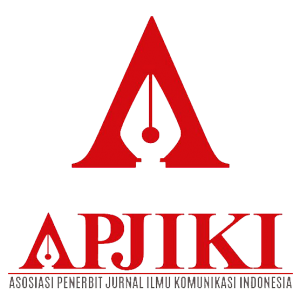Kajian Literatur Perspektif Industri dan Teknologi Komunikasi Terhadap Perkembangan Media Audio
Abstract
Keywords
Full Text:
PDFReferences
Adorno, T. W. (1990). On Popular Music. In On Record Rock, Pop and the Written Word (pp. 301–314). Routledge.
Adorno, T. W., & Bernstein, J. M. (2001). The Culture Industry: Selected Essays on Mass Culture. Routledge.
Arditi, D. (2019). Music Everywhere: Setting a Digital Music Trap. Critical Sociology, 45(4–5), 617–630. https://doi.org/10.1177/0896920517729192.
Balanuta, L. (2021). Podcast–Towards An Inclusive Definition. Acta Universitatis Danubius. Communicatio, 12(2), 31–41. https://dj.univ-danubius.ro/index.php/AUDC/article/view/1428/1755.
Barendregt, B., & van Zanten, W. (2002). Popular Music in Indonesia since 1998, in Particular Fusion, Indie and Islamic Music on Video Compact Discs and the Internet. Yearbook for Traditional Music, 34, 67–113. https://doi.org/10.2307/3649190.
Berg, F. S. A. (2021). Independent podcasts on the Apple Podcast platform in the streaming era. MedieKultur: Journal of Media and Communication Research, 37(70), 110–130. https://doi.org/10.7146/mediekultur.v37i70.122390.
Berg, F. S. A. (2022). The tension between podcasters and platforms: independent podcasters’ experiences of the paid subscription model. Creative Industries Journal, 15(1), 58–78. https://doi.org/10.1080/17510694.2021.1890417.
Berry, R. (2015). A Golden Age of Podcasting? Evaluating Serial in the Context of Podcast Histories. Journal of Radio & Audio Media, 22(2), 170–178. https://doi.org/10.1080/19376529.2015.1083363.
Berry, R. (2016a). Podcasting: Considering the evolution of the medium and its association with the word ‘radio.’ Radio Journal: International Studies in Broadcast & Audio Media, 14(1), 7–22. https://doi.org/10.1386/rjao.14.1.7_1.
Berry, R. (2016b). Part of the establishment: Reflecting on 10 Years of Podcasting as An Audio Medium. Convergence: The International Journal of Research into New Media Technologies, 22(6), 661–671. https://doi.org/10.1177/1354856516632105.
Bolter, J. D., & Grusin, R. (2000). Remediation: Understanding new media. MIT Press.
Bonini, T. (2015). The ‘second age’of podcasting: Reframing podcasting as a new digital mass medium. Quaderns Del CAC, 41(18), 21–30. https://www.cac.cat/sites/default/files/2019-01/Q41_Bonini_EN_0.pdf.
Borg, J. (2021). What is the future of the music industry? Ten predictions for the next ten years. AmplifyYou. https://amplifyyou.amplify.link/2021/06/what-is-the-future-of-the-music-industry-ten-predictions-for-the-next-ten-years/.
Bottomley, A. J. (2020). Sound Streams: A Cultural History of Radio-internet Convergence. University of Michigan Press.
Bruenger, D. (2016). Making money, making music : History and core concepts (1st editio). University of California Press.
Canavillhas, J. (2012). From remediation to convergence: looking at the Portuguese media. Brazilian Journalism Research, 8(1), 7–21. https://doi.org/10.25200/BJR.v8n1.2012.406.
Chan-Olmsted, S., Wang, R., & Hwang, K.-H. (2022). Millennials’ Adoption of Radio Station Apps: The Roles of Functionality, Technology, Media, and Brand Factors. Journalism & Mass Communication Quarterl, 99(1), 262–288. https://doi.org/https://doi.org/10.1177/1077699020952111.
Creswell, J. W., & Creswell, J. D. (2018). Research design (5th ed.). SAGE Publications Ltd.
Croteau, D., & Hoynes, W. (2018). Media/Society: Technology, Industries, Content, and Users (6th editio). SAGE Publications Ltd.
Csathy, P. (2020). The Future Of Music: Where It Is Today & Where It’s Going In The Next Decade. Forbes. https://www.forbes.com/sites/petercsathy/2020/02/02/the-future-of-music-where-it-is-today--where-its-going-in-the-next-decade/?sh=2089253b707e.
Darmanto, Masduki, & Wiryawan, H. (2022). Radio Broadcasting and Indonesian Nationalism: During the Last Decade of Dutch Colonialism. Journal of Radio & Audio Media, 99(1), 104–119. https://doi.org/https://doi.org/10.1080/19376529.2022.2035730.
Evandio, A. (2021). Optimistis Industri Podcast Cerah, Noice Siapkan Strategi Ini. Bisnis.Com. https://ekonomi.bisnis.com/read/20210101/12/1337643/optimistis-industri-podcast-cerah-noice-siapkan-strategi-ini.
Grant, A. E. (2016). The Communication Technology Ecosystem. In A. E. Grant & J. Meadows (Eds.), Communication Technology Update and Fundamentals (6th Editio, pp. 1–8). Routledge. https://doi.org/9781315537245.
Graumann, C. F., & Kallmeyer, W. (2002). Perspective and perspectivation in discourse. John Benjamins Publishing.
Hammersley. (2004). Audible Revolution. The Guardian. https://www.theguardian.com/media/2004/feb/12/broadcasting.digitalmedia
Heinich, R., Molenda, M., & Russell, J. D. (1996). Instructional media and technologies for learning (5th Editio). Von Hoffman Press, Inc.
Ismadianto, Suyanto, Latifah, K., & Muchid. (2022). Transformation of Radio Technology in The Digital Age. Nyimak: Journal of Communication, 6(1), 115–130. https://jurnal.umt.ac.id/index.php/nyimak/article/view/5547/3207.
Jenkins, H. (2006). Convergence Culture: Where Old and New Media Collide. New York University Press.
Juwita, S. R., & Endah, S. N. (2019). Classification of Indonesian Music Using the Convolutional Neural Network Method. 2019 3rd International Conference on Informatics and Computational Sciences (ICICoS), 1–5. https://doi.org/10.1109/ICICoS48119.2019.8982470.
Kuyucu, M. (2019). Digital Convergence of Radio: Effects of Digitalization on Radio Media. 6th International Communication Days Digital Transformation Symposium, 466–495.
Lai, R. (2020). The Commodification of Music in the Age of Curated Experience [University of Texas at Austin]. https://repositories.lib.utexas.edu/handle/2152/81238.
Laor, T. (2021). How does it ‘sound’? Audiences, broadcasters, and managers on visual radio in Israel. Convergence: The International Journal of Research into New Media Technologies, 27(4), 1038–1054. https://doi.org/10.1177/1354856520942404.
Laughey, D. (2007). Key Themes in Media Theory. Open University Press/McGraw-Hill.
Liebowitz, S. J. (2006). Economists Examine File Sharing and Music Sales. In G. Illing & M. Peitz (Eds.), Industrial Organization and the Digital Economy (pp. 145–173). MIT Press.
Lindsay, J. (1997). Making Waves: Private Radio and Local Identities in Indonesia, Language and Media. Language & Media, 64, 105–123.
Long, P., & Wall, T. (2012). Media Studies: Text, Production, and Context (2nd Editio). Routledge.
MacLennan, A. F. (2020). Editor’s Remarks: Celebrating 100 Years of Radio Broadcasting! Journal of Radio & Audio Media, 27(2), 187–190. https://doi.org/10.1080/19376529.2020.1831864.
Maxwell, M. G. (2015). Machine Tool Operation, Weekly Indie Music Podcast: Independent Music From SoundCloud Users. Journal of Radio & Audio Media, 22(2), 348–351. https://doi.org/10.1080/19376529.2015.1083381.
McHugh, S. (2014). Audio Storytelling. Asia Pacific Media Educator, 24(2), 141–156. https://doi.org/10.1177/1326365X14555277.
Metzger, P. (2016). The Millennial Whoop: A Glorious Obsession With The Melodic Alternation Between The Fifth And The Third. The Patterning. https://thepatterning.com/2016/08/20/the-millennial-whoop-a-glorious-obsession-with-the-melodic-alternation-between-the-fifth-and-the-third/.
Moe, M. (2021). Podvertising II: “Just like My Best Friend” – Relationships in Host-read Podcast Advertisements. Journal of Radio & Audio Media, 1–25. https://doi.org/10.1080/19376529.2021.1960840.
Moore, R. (2012). Digital Reproducibility and the Culture Industry: Popular Music and the Adorno-Benjamin Debate. Fast Capitalism, 9(1), 75–88. https://doi.org/10.32855/fcapital.201201.010.
O’Neill, B. (2008). Digital Radio Policy in Canada: From Analog Replacement to Multimedia Convergence. Journal of Radio & Audio Media, 15(1), 26–40. https://doi.org/10.1080/19376520801978126.
Octavia, E. R. (2018). The Existence Of Radio As Advertising Media In Indonesia Within The Internet Era. Proceedings of the 3rd International Conference on Creative Media, Design and Technology (REKA 2018), 333–338. https://doi.org/http://dx.doi.org/10.2991/reka-18.2018.73.
Press, G. (2015). A Very Short History of Digitization. Forbes. Forbes. https://www.forbes.com/sites/gilpress/2015/12/27/a-very-short-history-of-digitization/?sh=73f20ea149ac.
Prey, R. (2018). Nothing personal: algorithmic individuation on music streaming platforms. Media, Culture & Society, 40(7), 1086–1100. https://doi.org/10.1177/0163443717745147
Prey, R., Esteve Del Valle, M., & Zwerwer, L. (2022). Platform pop: disentangling Spotify’s intermediary role in the music industry. Information, Communication & Society, 25(1), 74–92. https://doi.org/10.1080/1369118X.2020.1761859.
Primasita, F. A., Susilorini, & Kusciati, K. P. (2016). Perception toward the construction of women’s body and sexuality in the video clips of Indonesian women pop singers. SEARCH Journal of Media and Communication Research, 8(1), 78–104. https://www.researchgate.net/publication/298713965_Perception_toward_the_construction_of_women’s_body_and_sexuality_in_the_video_clips_of_Indonesian_women_pop_singers.
Reed, T. V. (2019). Digitized lives: Culture, Power and Social Change in the Internet Era (2nd Editio). Routledge.
Riyanto, E. D., & Dewi, A. S. (2020). Via Vallen Phenomenon: Emergence of the New Queen of Cosmopolitan Koplo. Popular Entertainment Studies, 11(1–2), 66–80.
Shahid, S. H., & Ali, Z. (2017). Effects of video-podcasts on listening comprehension of Saudi EFL learners. European Journal of English Language Teaching, 2(4), 169–194. https://doi.org/10.5281/zenodo.891143.
Singarimbun, K., Karlinah, S., Darwis, Y., & Hidayat, D. R. (2023). Indonesian radio business model: radio network. Journal of Media Business Studies, 20(1), 93–108. https://doi.org/10.1080/16522354.2021.2024983.
Snyder, H. (2019). Literature review as a research methodology: an overview and guidelines. Journal of Business Research, 333–339. https://doi.org/https://doi.org/10.1016/j.jbusres.2019.07.039.
Tejkalova, A. N., Gheorghiev, O., Supa, M., & Nainova, V. (2021). Children and the Radio: Who Should Listen to Whom?. Journalism Practice. https://doi.org/https://doi.org/10.1080/17512786.2021.2011377.
U.S. Fire Administration. (2016). Voice Radio Communications Guide for the Fire Service. U.S. Department of Homeland Security.
United Nations Development Programme. (2004). UN Social Economic Council’s Report of the International Telecommunication Union on information and communication technologies statistics. https://digitallibrary.un.org/record/515803?ln=en.
Vonderau, P. (2019). The Spotify effect: Digital distribution and financial growth. Television & New Media, 20(1), 3–19. https://doi.org/https://doi.org/10.1177/1527476417741200.
Wade Morris, J. (2021). Infrastructures of discovery: examining podcast ratings and rankings. Cultural Studies, 35(4–5), 728–749. https://doi.org/10.1080/09502386.2021.1895246.
Wadegaonkar, D. W. (1981). Concept of Industry. Journal of the Indian Law Institute, 23(3), 400–420. https://www.jstor.org/stable/43950760.
Waldfogel, J. (2017). How Digitization Has Created a Golden Age of Music, Movies, Books, and Television. Journal of Economic Perspectives, 31(3), 195–214. https://doi.org/10.1257/jep.31.3.195.
Wang, R. (2021). Reasons and Influences in Music Communication with Traditional Broadcast in the Context of Media Convergence. Advances in Social Science, Education and Humanities Research, 697–702. https://doi.org/10.2991/assehr.k.220105.128.
Weintraub, A. N. (2013). The Sound and Spectacle of Dangdut Koplo: Genre and Counter-Genre in East Java, Indonesia. Asian Music, 44(2), 160–194. https://www.jstor.org/stable/24256937.
Zhang, Q., & Negus, K. (2021). Stages, Platforms, Streams: The Economies and Industries of Live Music after Digitalization. Popular Music and Society, 44(5), 539–557. https://doi.org/https://doi.org/10.1080/03007766.2021.1921909.
Zuidervaart, L. (2015). Theodor W. Adorno (Stanford encyclopedia of philosophy). Stanford Encyclopedia of Philosophy. https://plato.stanford.edu/archives/win2015/entries/adorno/.
DOI: https://doi.org/10.36080/ag.v11i1.2327
Refbacks
- There are currently no refbacks.
Copyright (c) 2023 Avant Garde

This work is licensed under a
Creative Commons Attribution-ShareAlike 4.0 International License. Visit to our university official website: www.budiluhur.ac.id





